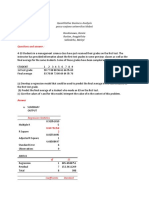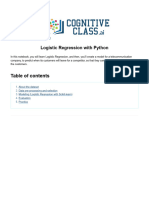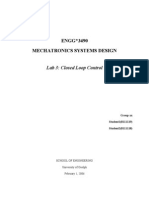0 ratings0% found this document useful (0 votes)
3 viewsStatistical Modelling Assignment II
The document outlines an assignment involving the analysis of two datasets: mosquito death data and graduate admission data. It details the use of logistic regression to analyze the graduate admission dataset, which includes variables such as GRE scores, GPA, and rank, and provides insights into how these factors affect admission odds. The results include coefficients for each predictor and their significance, along with confidence intervals and model fit measures.
Uploaded by
singhvasudha1095Copyright
© © All Rights Reserved
Available Formats
Download as DOCX, PDF, TXT or read online on Scribd
0 ratings0% found this document useful (0 votes)
3 viewsStatistical Modelling Assignment II
The document outlines an assignment involving the analysis of two datasets: mosquito death data and graduate admission data. It details the use of logistic regression to analyze the graduate admission dataset, which includes variables such as GRE scores, GPA, and rank, and provides insights into how these factors affect admission odds. The results include coefficients for each predictor and their significance, along with confidence intervals and model fit measures.
Uploaded by
singhvasudha1095Copyright
© © All Rights Reserved
Available Formats
Download as DOCX, PDF, TXT or read online on Scribd
You are on page 1/ 3
Statistical Modelling Assignment II
Please analysis the following data and submit a report based on
the analysis.
Data I: Mosquito death data
Data II: Graduate admission data
Case I: Graduate Admission Data:
For our data analysis below, we have imported a data set from
the website which gives us information about Graduate
Admission Data.
data1 = read.csv("https://stats.idre.ucla.edu/stat/data/binary.csv")
head(data1)
admit gre gpa rank
1 0 380 3.61 3
2 1 660 3.67 3
3 1 800 4.00 1
4 1 640 3.19 4
5 0 520 2.93 4
6 1 760 3.00 2
This dataset has a binary response variable called admit. There
are three predictor variables: gre, gpa and rank. We treat the
variables gre and gpa as continuous variables. We can get the
basic descriptive for the entire dataset using summary.
summary(data1)
admit gre gpa rank
Min. :0.0000 Min. :220.0 Min. :2.260 Min. :1.000
1st Qu.:0.0000 1st Qu.:520.0 1st Qu.:3.130 1st Qu.:2.000
Median :0.0000 Median :580.0 Median :3.395 Median :2.000
Mean :0.3175 Mean :587.7 Mean :3.390 Mean :2.485
3rd Qu.:1.0000 3rd Qu.:660.0 3rd Qu.:3.670 3rd Qu.:3.000
Max. :1.0000 Max. :800.0 Max. :4.000 Max. :4.000
Using the Logistic Regression Model:
The code below estimates a logistic regression model using
the glm (generalized linear model) function. First, we
convert rank to a factor to indicate that rank should be treated
as a categorical variable. Then to get the results, we use the
summary command.
data1$rank = factor(data1$rank)
logit = glm(admit ~ gre + gpa + rank, data = data1, family = 'binomial')
summary(logit)
Call:
glm(formula = admit ~ gre + gpa + rank, family = "binomial",
data = data1)
Deviance Residuals:
Min 1Q Median 3Q Max
-1.6268 -0.8662 -0.6388 1.1490 2.0790
Coefficients:
Estimate Std. Error z value Pr(>|z|)
(Intercept) -3.989979 1.139951 -3.500 0.000465 ***
gre 0.002264 0.001094 2.070 0.038465 *
gpa 0.804038 0.331819 2.423 0.015388 *
rank2 -0.675443 0.316490 -2.134 0.032829 *
rank3 -1.340204 0.345306 -3.881 0.000104 ***
rank4 -1.551464 0.417832 -3.713 0.000205 ***
---
Signif. codes:
0 ‘***’ 0.001 ‘**’ 0.01 ‘*’ 0.05 ‘.’ 0.1 ‘ ’ 1
(Dispersion parameter for binomial family taken to be 1)
Null deviance: 499.98 on 399 degrees of freedom
Residual deviance: 458.52 on 394 degrees of freedom
AIC: 470.52
Number of Fisher Scoring iterations: 4
The logistic regression coefficients give the change in the log
odds of the outcome for a one unit increase in the predictor
variable.
For every one-unit change in gre, the log odds of admission
(versus non – admission) increases by 0.002.
For a one unit increase in gpa, the log odds of being
admitted to graduate school increases by 0.804.
Having attended an undergraduate institution with rank of
2, versus an institution with a rank of 1, changes the log
odds of admission by -0.675.
Having attended an undergraduate institution with rank of
3, versus an institution with a rank of 1, changes the log
odds of admission by -1.34.
Having attended an undergraduate institution with rank of
4, versus an institution with a rank of 1, changes the log
odds of admission by -1.55.
We can use confint function to obtain confidence estimates.
confint(logit) # Confidence Intervals using profiled log – likelihood.
Waiting for profiling to be done...
2.5 % 97.5 %
(Intercept) -6.2716202334 -1.792547080
gre 0.0001375921 0.004435874
gpa 0.1602959439 1.464142727
rank2 -1.3008888002 -0.056745722
rank3 -2.0276713127 -0.670372346
rank4 -2.4000265384 -0.753542605
We can also check the measures of how well our model fits. One
measure of model fit is the significance of the overall model.
This test asks whether the model with predictors fits significantly
better than a model with just an intercept (a null model).
with(logit, null.deviance - deviance)
[1] 41.45903
Finally, the p-value can be obtained as:
with(logit, pchisq(null.deviance - deviance, df.null - df.residual,
lower.tail = FALSE))
[1] 7.578194e-08
You might also like
- Apache Cassandra Administrator Associate - Exam Practice TestsFrom EverandApache Cassandra Administrator Associate - Exam Practice TestsNo ratings yet
- Logit Regression - R Data Analysis ExamplesNo ratings yetLogit Regression - R Data Analysis Examples12 pages
- Lab-4: Regression Analysis: Logistic & Multinomial Logistic RegressionNo ratings yetLab-4: Regression Analysis: Logistic & Multinomial Logistic Regression10 pages
- Poisson Regression - Stata Data Analysis ExamplesNo ratings yetPoisson Regression - Stata Data Analysis Examples12 pages
- Isolated Digit Recognizer Using Gaussian Mixture ModelsNo ratings yetIsolated Digit Recognizer Using Gaussian Mixture Models44 pages
- PUBG: A Guide To Free Chicken Dinner: Wenxin Wei, Xin Lu, Yang Li December 13, 2018No ratings yetPUBG: A Guide To Free Chicken Dinner: Wenxin Wei, Xin Lu, Yang Li December 13, 20186 pages
- Multinomial Logit Models With R: Library (Mlogit)No ratings yetMultinomial Logit Models With R: Library (Mlogit)8 pages
- ENGG 3490 Mechatronics Systems Design: Lab 3: Closed Loop ControlNo ratings yetENGG 3490 Mechatronics Systems Design: Lab 3: Closed Loop Control11 pages
- Ai Model for Predicting Stock Market Movement , DSDM Boo Chang GyuNo ratings yetAi Model for Predicting Stock Market Movement , DSDM Boo Chang Gyu7 pages
- Optimizing the Hyperparameters 1693296270No ratings yetOptimizing the Hyperparameters 169329627011 pages
- Part 3 - Intro To Policy Optimization - Spinning Up Documentation PDFNo ratings yetPart 3 - Intro To Policy Optimization - Spinning Up Documentation PDF10 pages
- Student Solutions Manual to Accompany Loss Models: From Data to Decisions, Fourth EditionFrom EverandStudent Solutions Manual to Accompany Loss Models: From Data to Decisions, Fourth Edition4/5 (1)
- BS EN 24920-1992, ISO 4920-1981 Textiles. Determination of Resistance To Surface Wetting (Spray Test) of FabricsNo ratings yetBS EN 24920-1992, ISO 4920-1981 Textiles. Determination of Resistance To Surface Wetting (Spray Test) of Fabrics12 pages
- Parameters For Selection of Pumps For Different Applications67% (3)Parameters For Selection of Pumps For Different Applications10 pages
- ARCON SI-350-N Solar Collector: ConstructionNo ratings yetARCON SI-350-N Solar Collector: Construction1 page
- Faber Kabel Cables Apantallados Sondas Temperatura 030326No ratings yetFaber Kabel Cables Apantallados Sondas Temperatura 0303265 pages
- R1-200xxxx FL Summary On The Maintenance of 2-Step RACH - v000No ratings yetR1-200xxxx FL Summary On The Maintenance of 2-Step RACH - v00013 pages
- Heart Images - Free Photos, PNG Stickers, Wallpapers & Backgrounds - RawpixelNo ratings yetHeart Images - Free Photos, PNG Stickers, Wallpapers & Backgrounds - Rawpixel1 page
- 02 Laboratory Exercise 1 - ARG (Application Development - Prelim)No ratings yet02 Laboratory Exercise 1 - ARG (Application Development - Prelim)2 pages
- An Introduction To The AWS Command Line Tool - LinuxNo ratings yetAn Introduction To The AWS Command Line Tool - Linux5 pages
- TutorialNuclear Power - Industrial-Craft-WikiNo ratings yetTutorialNuclear Power - Industrial-Craft-Wiki3 pages
- I I I I I I I I: Studies and Analyses Space Shuttle EngineNo ratings yetI I I I I I I I: Studies and Analyses Space Shuttle Engine601 pages
- Fake Social Media Profile Detection and ReportingNo ratings yetFake Social Media Profile Detection and Reporting6 pages
- RS-485 2X227 AWG SFUTP PVC - 9FY7F1V129 - V - 1 - R - 1No ratings yetRS-485 2X227 AWG SFUTP PVC - 9FY7F1V129 - V - 1 - R - 12 pages
































































































